In the last few years, Notion has become one of the most popular tools for project management. This is due to Notion's versatility, in comparison to other project management tools like Trello, Asana or Monday.
Some say Notion is like Lego: based on simple blocks, you can build almost any tool you can think of for your business or personal life.
In this article, you'll find:
- What are the key features for managing projects in Notion
- How to start using Notion for project management in 3 steps
- How to use a pre-built Notion project management template
By the way, if you are willing to use Notion for other personal or business needs, you should check out comprehensive roundup of the latest best Notion templates.
Ok now, Ready? Let's get to it!
{{cta-1}}
Notion Project Management: Overview of the Notion's Key Features
If you loved building your dream worlds with Lego as a kid, you'll now love building your dream tools with Notion.
“Text, images, lists, a row in a database, even pages themselves — these are all blocks, dynamic units of information that can be transformed into other block types or moved freely within Notion” - notion.so
As a result, you have full flexibility to build a system with dashboards for managing simple and complex projects of any size.
For task management and project management, that would primarily be:
- The ability to create task lists with customizable project steps (Active, On Hold, Done)
- Multiple ways to visualize data like Kanban Boards or Gallery View
- The possibility of creating easy to use custom dashboards
- The option to assign team member roles and give different permission access
Let's go through the main Notion features that you'll need to create your own project management tool.
Relational Databases to Power your Notion Project Management System
The power of Notion is that it lets you create your own databases and connect them together the way you want.
This is a key feature for project management because it allows you to express useful relationships between items in different databases. For example, to link tasks inside the task database with specific projects inside the project database.
Lets’s say that you want to know which task are still open for a project. Simply, add a relation property in the task database that is then connected with the project database.
- Add a new column/property to your Task database.
- In the property menu, give it a name in the box provided, like “Projects”
- Choose “Relations” from the menu.
- Notion will now ask you to select a database from your workspace. Simply use the search function to find the right database (in this case “Projects”).
- If you are now clicking on the cell in the relation property, you can add items from the connected database. In this case, we are choosing the name of the project that is connected with our task.
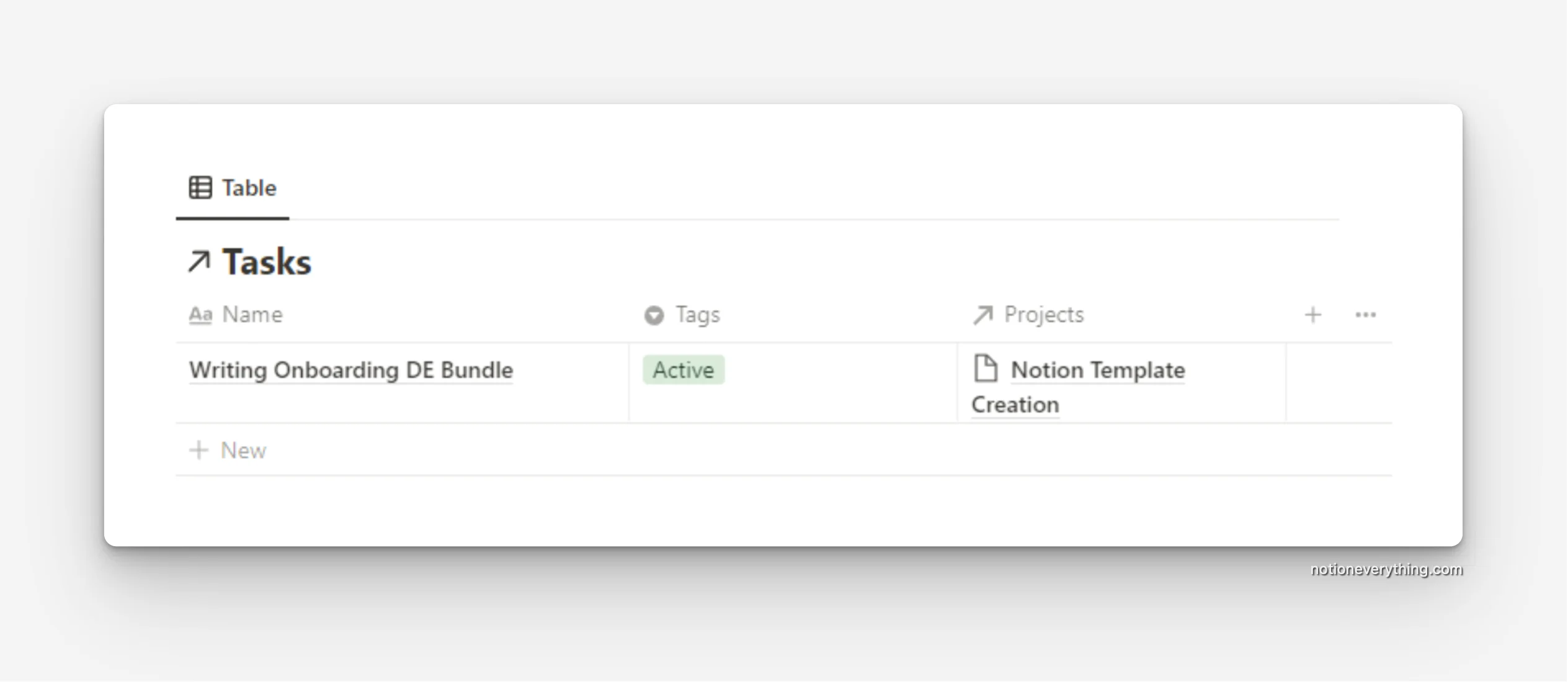
If we are now looking at the Projects database, we see the tasks connected with our project.
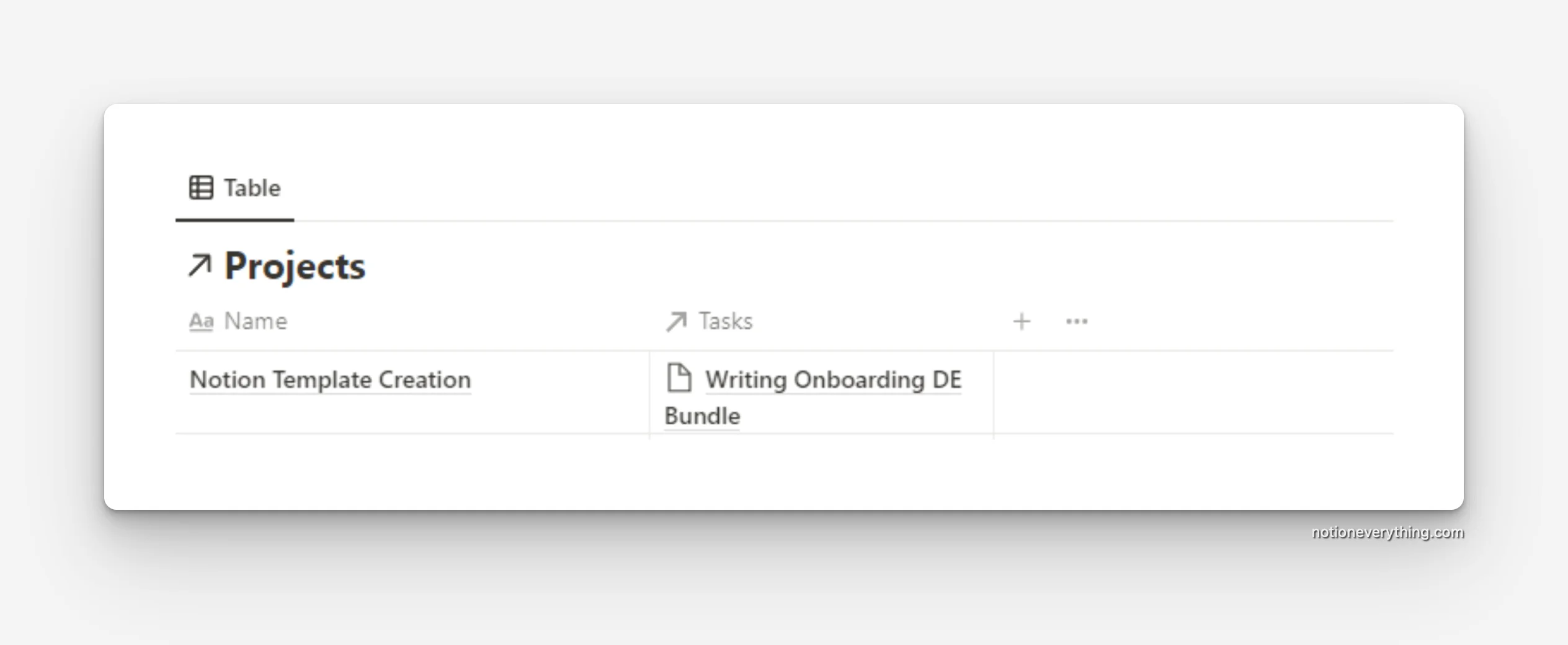
Database Views to Create Project Management Dashboards
Another key feature that you'll need to seamlessly manage all your tasks with Notion is the ability to visualize your database in many ways.
Notion layouts let you chose the right view depending on how you want to display the information stored in your databases.
You can use the following six layouts in Notion:
- List
- Gallery
- Table
- Board (Kanban Board)
- Calendar
- Timeline (Gantt Chart)
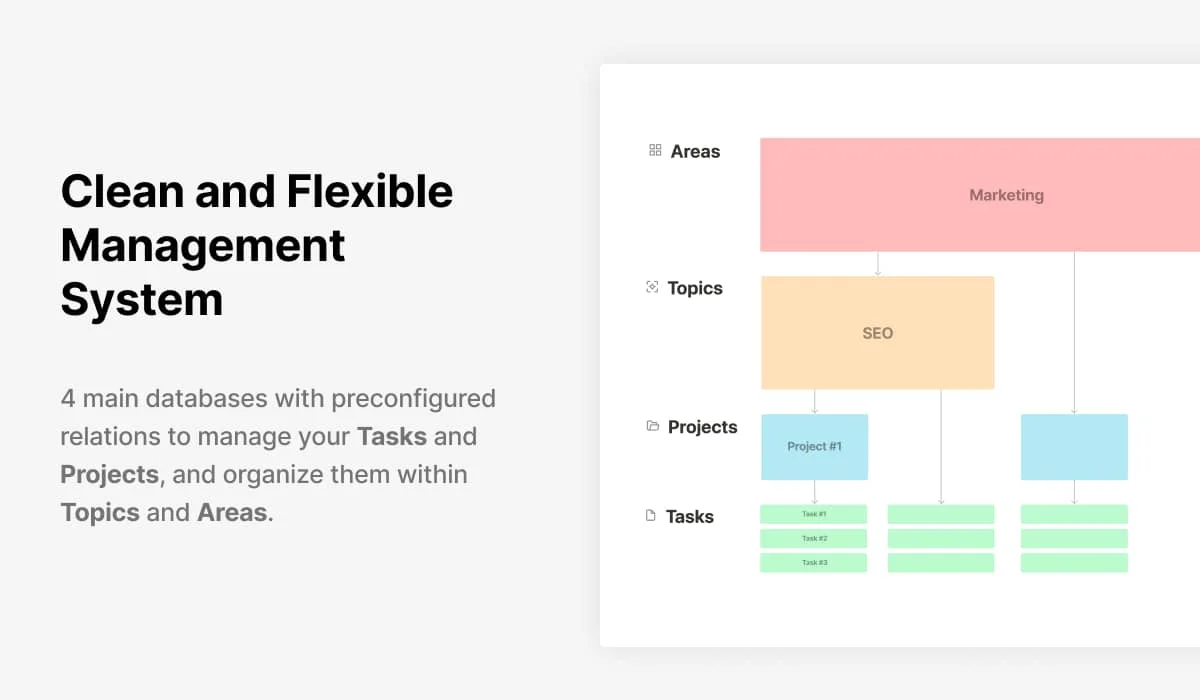
The two most popular views for an efficient Notion project management system are the Trello-style Kanban Board View, and the Timeline View (which serves as an enhanced Gantt Chart).
Kanban Boards
Kanban boards are perfect for task management with projects that require tasks moving through different stages. Project tasks usually go through the Todo, In Progress and Completed stages. But you can customize them to your needs, using for example stages like Researching, Writing, and Proofreading for the process of writing this blog post.
They are popular for their ability to visualize complex processes and their ease of use: when a task needs to move to the next stage, a user can simply drag it into the right column.
Timeline View (Gantt Charts)
The timeline view in Notion is basically an improved Gantt Chart, which lets you easily keep an eye on your development process.
Simply said, Gantt Charts are used to show a project schedule on a bar chart. It's particularly useful to view the planning of tasks (with due date) for a project, or of active projects a team has to perform.
This chart type helps to better visualize deadlines and gives you the flexibility to easily adjust the duration of a project when needed.
Collaboration to Share Your Notion Workspace
With Notion, you can share pages with your team members, clients, or the whole world. This allows a team in Notion to work together regardless of whether they are based in California or on Fiji island.
There's also no limit on the number of people who can view and edit the same page or database at the same time. Therefore, Notion can be used by both small companies or large corporations.
This lets you manage multiple projects (internal or external) from your own workspace and makes assigning tasks to collaborators super easy.
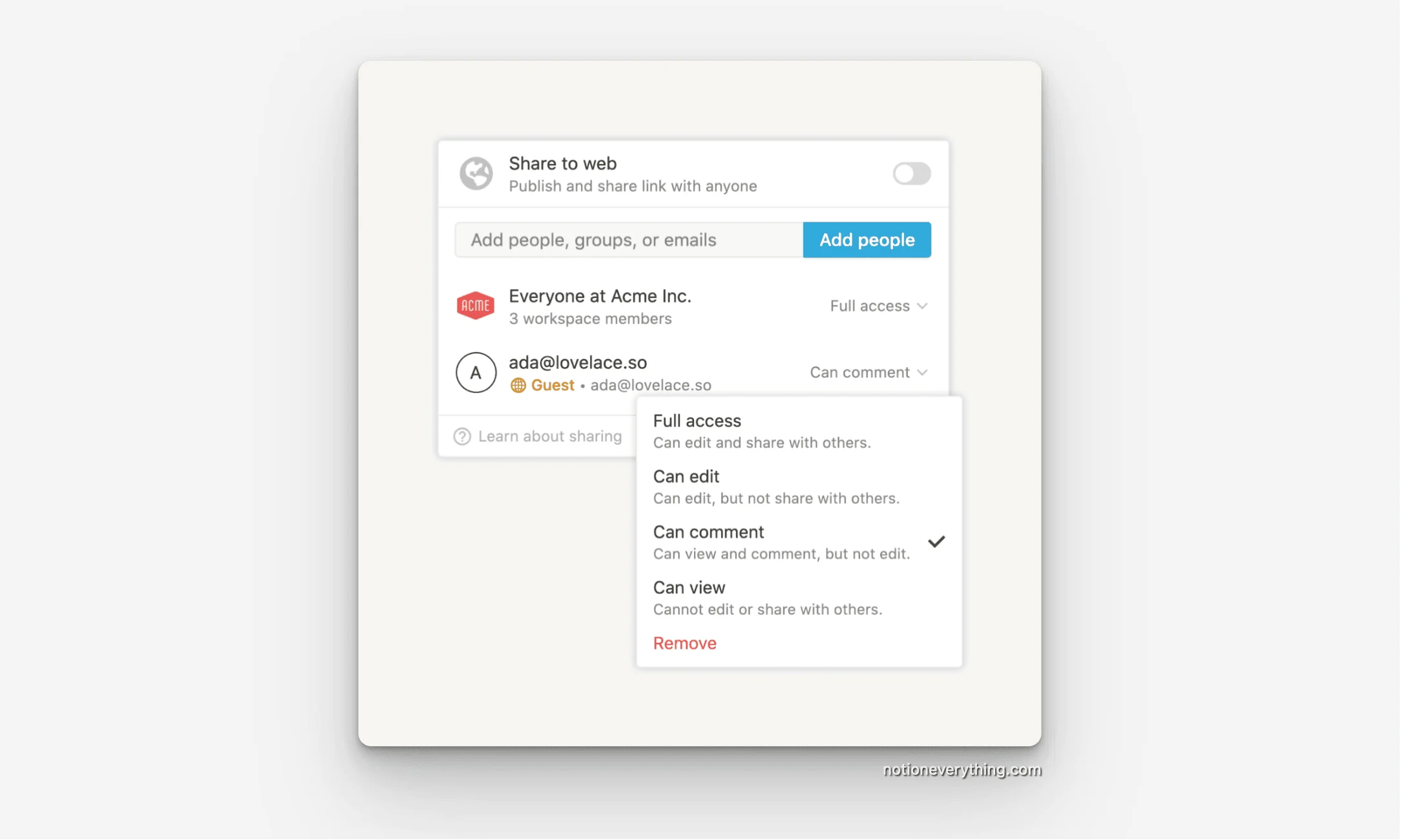
Sharing of a Notion page
This option allows you to manage access to some of your Notion pages, but not to your whole project management workspace. You can add up to five Guests with the Notion's Personal plan (free). This makes it an interesting option for freelancers or small businesses, that are not collaborating with team members on a regular basis.
Simply click on “Share” in the top right sidebar and use the option “invite” to give a specific person access to a Notion page. Of course, you can also assign different permission levels like read, comment or edit.
Admins and Members
When on a Team or Enterprise Plans, you can add additional Members to your workspace. There is no limit on how many users you can add to your workspace. This is the right option for managing tasks and projects within internal teams of any size.
To do so, use the “Members” menu in the top left sidebar.
When adding an admin, you give the person permission to edit settings and invite new members.
When you don't want to give someone control over the settings, simply assign the member status to this user. Members can create and edit Notion pages in a workspace, but can’t edit settings or add new members.
Updates and Notifications
When collaborating on your projects, being able to notify team members about any updates or deadline changes is vital.
Notion offers four ways to trigger notifications for guests and members. This has the advantage that projects participants only receive notifications that are relevant to them.
They can get notified when:
- Somebody mentions a member with the tag @ on a page
- A person is added to a database
- They have set a reminder to get a notification at a specific time
- Somebody edits a page they are following
There are several ways notifications can reach members, depending on whether you use Notion's desktop app or mobile app:
- Mobile Push
- Desktop Push
- Email notifications
- Always send email notifications
Each option has its own particularity, which you can learn more about on Notion's help center. Of course, every notification type can be turned on or off in the notifications settings.
How to Use Notion for Project Management?
Notion allows you to build project management systems of different levels of complexity. But whatever your particular needs, you will need at least a few key elements.
Here is what you'd need to do to leverage Notion's powerful capabilities as a project management tool:
1. Create your System's Structure With Databases
First off, you will need to create at least two databases: one for your projects and another one for your tasks.
For each of these databases, you can create properties like:
- Due date
- Status (Todo, In progress, Completed)
- Task owner / Project manager
Then, you will want to create a relation between both databases so that you can link tasks to specific projects. The linking is done by using a “Relation” property as shown previously in this article.
If you want to take your project management tool to the next level, you can add more databases to the system such as areas, topics, objectives, or anything that fits your needs.
2. Create Custom Views
Depending on the type of organization or project, you can now create different database views by using layouts like tables, calendar, timelines (Gantt Charts) or Kanban boards.
- Tables are mostly used to show your team members a general list of tasks that need to be done. Lately, it has become popular in the Notion community to use frameworks within the table view like the Eisenhower Matrix to calculate the priority of tasks.
- Calendar and timeline views are used when tasks or projects are time-dependent, requiring your team to meet a specific deadline.
- Lastly, as mentioned in the beginning, the Kanban view is best used for tasks that need to pass different stages before completion.
3. Create Dashboards
Once you have created your databases and views that best fit the way you manage your projects, you now need to be able to simply view and use your system.
For this, we recommend creating dedicated dashboards in order to display tasks and projects contextually.
This is done by using what Notion calls "linked views of databases" which allows you to add views of existing databases and use filters to only display relevant tasks and projects.
You can start by creating 3 types of dashboards:
General Dashboards
Use general dashboards for an overall view of tasks and projects, their status, and deadlines. You can also create dashboards for specific areas of your business or specific teams to only see tasks and projects related to them.
Individual Dashboards for Team Members
Individual dashboards should be used to show tasks that are relevant to specific team members. To do this, you can either:
- Create a Notion page for each team member and filter the database views by the relevant person.
- Create only one page and filter the database views by "Me" in a Person property. In that case, the views will only display tasks and projects for which the current user is involved in.
Project Dashboards
Depending on the complexity of your projects, you might need to have dedicated dashboards for each project. These should only show tasks linked to a specific project.
This is where you'd want to use the timeline view when a project consists of many consecutive tasks. You might also use a board view to quickly see the status of all the project's tasks.
To easily implement this without having to create a new dashboard each time you create a new project, you should create your dashboard in a database template. This way, you'll only have to click one button in order to load your dashboard template for all project pages.
Notion Project Management Template
Now that you know how to set up Notion for project management, you might be wondering if it is possible to have a powerful system for managing more complex projects.
Luckily for you, we've created a Notion template which includes advanced project management features.
Our Task and Project Management Notion template is perfect for startups and small businesses, as well as independent entrepreneurs and freelancers.

It allows you to manage all your projects and tasks in the most organized and efficient way possible.
A great option to get a robust structure for managing your business or personal projects.
Here is what this Notion template will allow you to do.
Manage Large Projects in Notion With a Flexible System
While you can use this template as a solopreneur or even for small personal projects, its strengths come to light when people use it to manage large operations or projects.
Let’s look at the structure of our project management template.
It is built on top of four mains databases which are: areas, topics, projects and tasks.
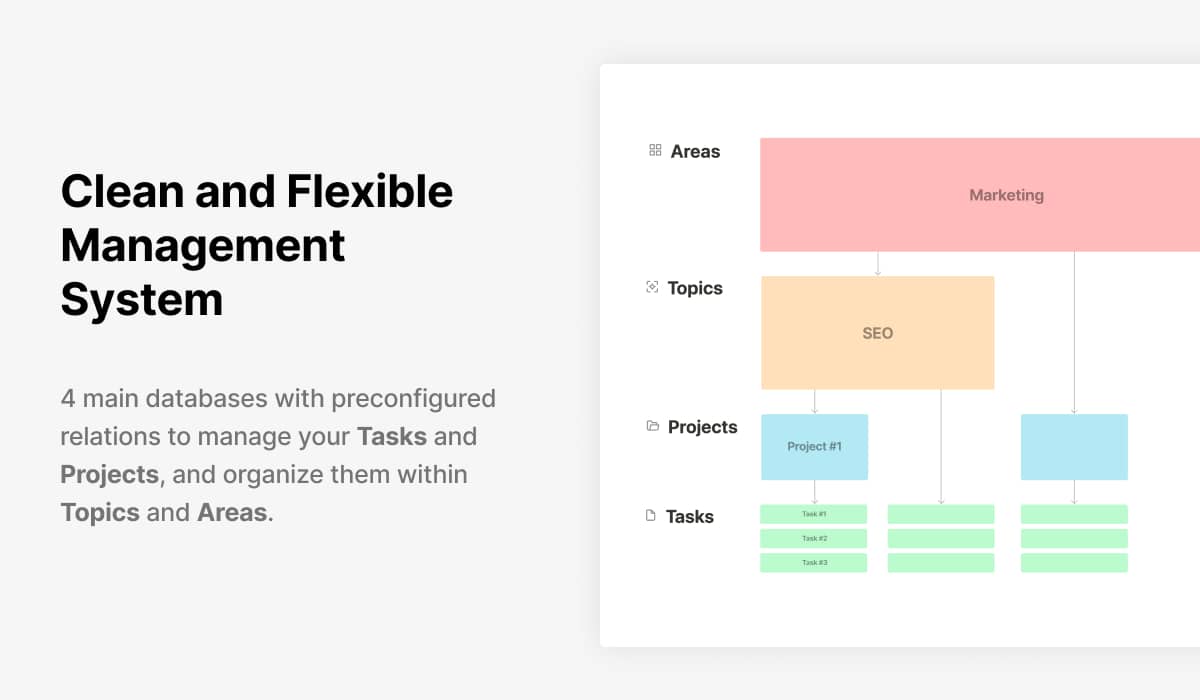
Areas
Areas are domains of your business or high-level categories of your work or life. This template is prefilled with 6 areas that are common internal operations to most businesses. You can easily customize them according to the type of projects you want to use this template for.
Topics
Topics are subdomains or categories of areas. They help you categorize your projects for a clean organization. This template is also prefilled with example topics for each area. You can delete or add topics according to your needs.
While projects are time-dependent and typically have a beginning and end date, topics cover areas like Office Management, Website Maintenance or SEO that have no expiration date.
Projects
Projects are groups of tasks that can be linked to topics or directly to areas. You can give them due dates and optionally add start dates to create timeframes for your projects. Projects can also be tracked by month, quarter, and year.
One of the interesting features of this project management template is the ability to track project progress visually. For each project, a progress bar shows the percentage of completed project tasks.
Tasks
For task management, each task can either be linked to a project or to a topic. Tasks can be easily prioritized with statuses and priority levels that you can customize to your liking.
Of course, you can assign tasks to different users and define specific due dates.
Focus on Important Projects and Tasks With Dashboards
The power of this template is that it comes with a set of useful pre-configured dashboards.
- Master dashboards that show everything that is going on and lets you quickly access all your Areas, Topics, Projects and Tasks.
- Personal dashboards that only shows relevant information for a particular user.
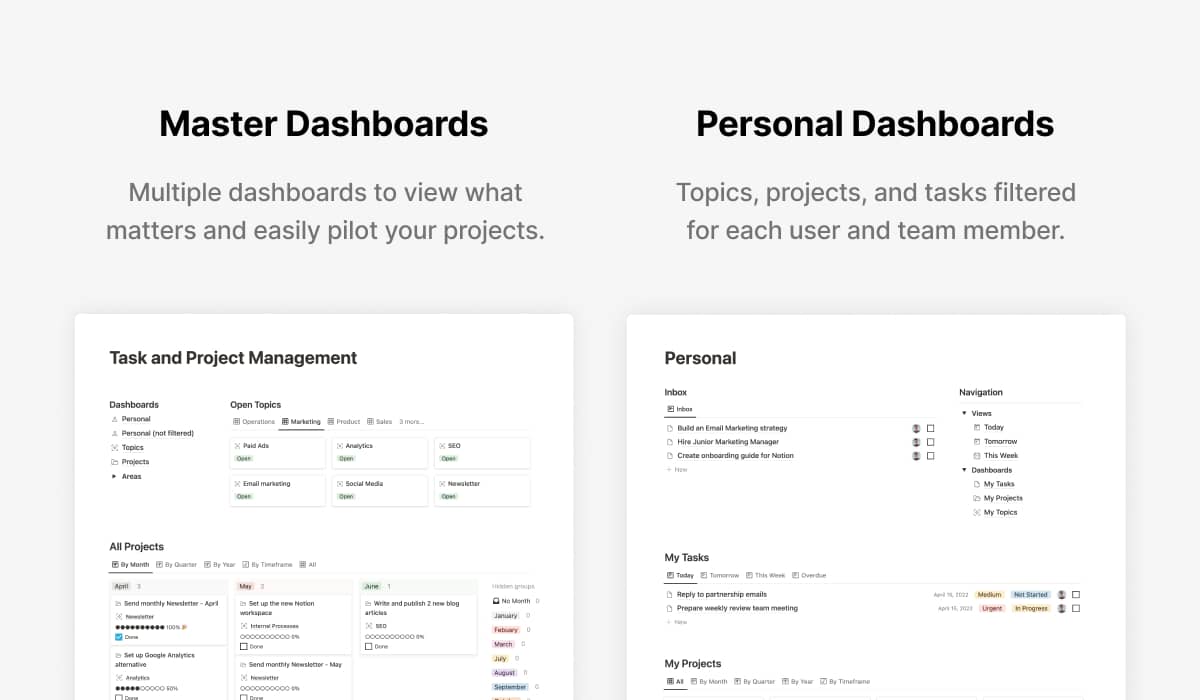
These dashboards allow you to never lose track of what is going on, who's working on what, what are the current priorities and deadlines. You'll be able to focus on the right project and the right task, at the right time.
Customize Your Project Management System
The best part of this template is that it is built in a way that is 100% customizable to your needs and organization thanks to multiple views.
it includes more than 30 prebuilt database views to always visualize the information in the most relevant way.
With 30+ Kanban boards, Gantt charts, galleries and lists, you'll be able to customize your dashboards so that your project management system works perfectly for you.
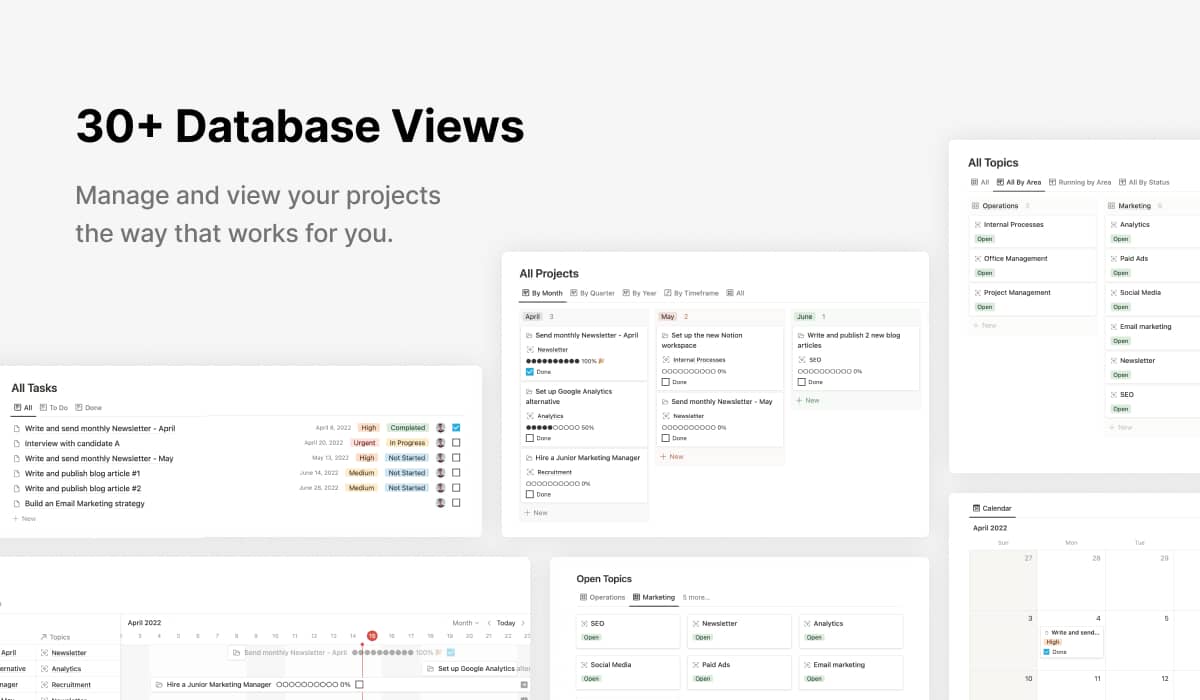
Conclusion
Notion is not only one of the best knowledge management tool on the market. It is so complete that it also allows creating different systems, including a powerful project management tool like we just presented.
With this article, you should now know everything about how to create your own Project Management System in Notion.
But if you want to save hours building everything from scratch, you can get our Notion project management template and start in a matter of seconds. It is simple and flexible enough to fit your needs and help you meet your business goals.
Now, ready to enjoy the power of Notion for project management?


.webp)






.webp)


